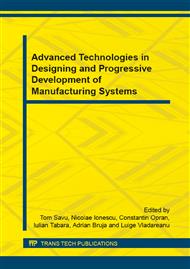p.199
p.205
p.213
p.219
p.225
p.233
p.239
p.245
p.251
The Analysis of Performances of an Assembly Line in Strike-Zone Supply Method Managed with Kanban and Conwip
Abstract:
The present paper is part of a larger study of the authors, which consists in the analysis of performances of several production systems. On a multiproduct assembly line supplied in Strike-Zone, are made researches on the influence of the method of production flow management, the method of launching in production and by varying the clients demand size on several performance indicators. The assembly line has mainly manual activities, divided in 5 workstations. The line produces two types of similar products. Using dynamic simulation (Arena software) that mimics the lines functioning mode, different experimental conditions are created, determined by the variation of the above mentioned parameters, following the evolution of the performance indicators: average work in process, cost per unit, systems reactivity to client demand and throughput. The obtained results were interpreted and structured, in a manner to help the process managers to take adequate decisions considering the wanted objectives.
Info:
Periodical:
Pages:
225-230
Citation:
Online since:
May 2015
Authors:
Keywords:
Price:
Сopyright:
© 2015 Trans Tech Publications Ltd. All Rights Reserved
Share:
Citation:


